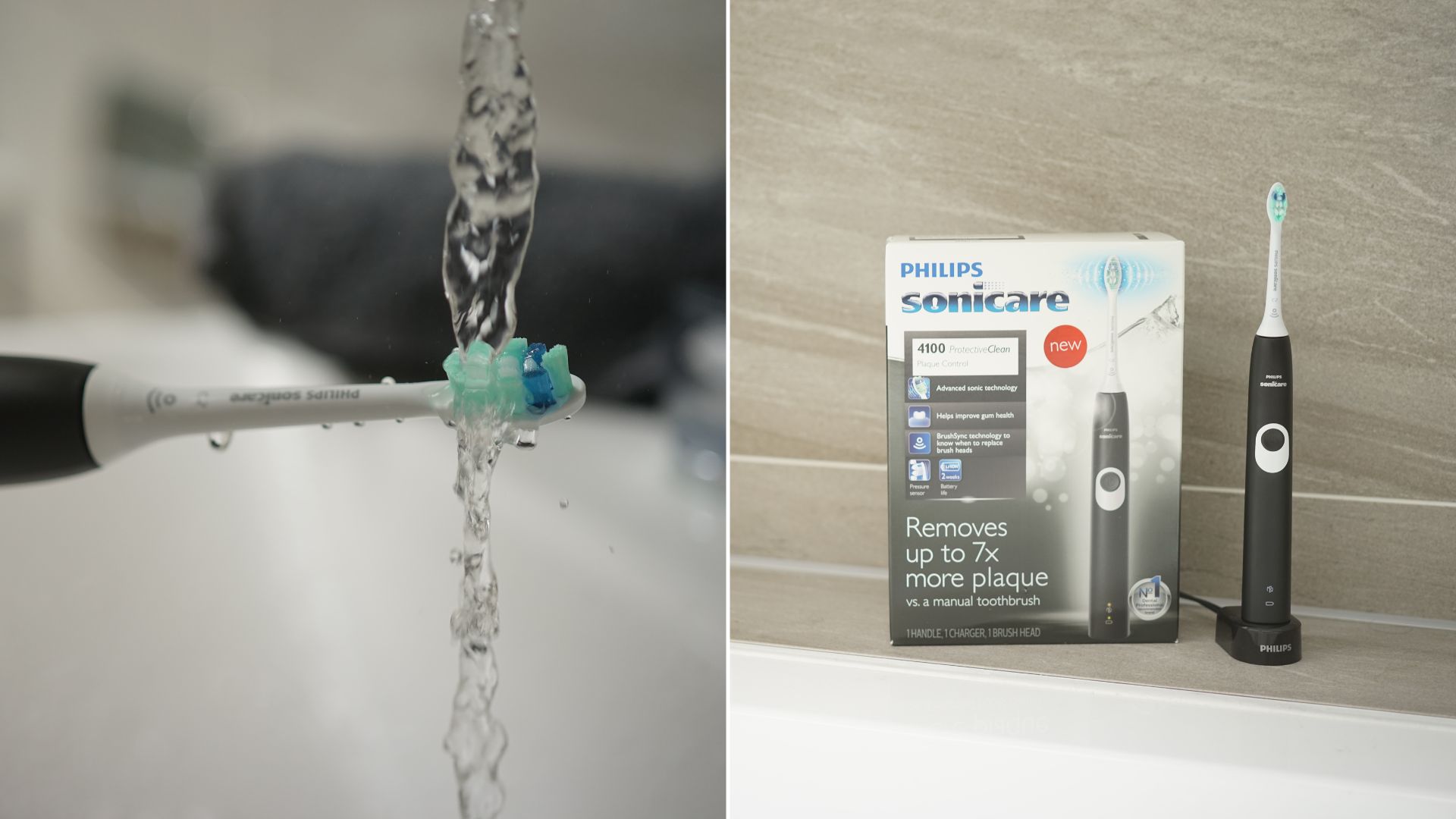
Editor's Note
The ProtectiveClean 4100 is being discontinued. It has been replaced with the 4100 Series.
Read our comparison to see how the ProtectiveClean 4100 and the 4100 Series compare.
Fantastic - a must buy - ideal for new & experienced electric toothbrush users
A stunning example of the products available today.
The ProtectiveClean 4100 has all the essential features, plus a few very useful extras without a massive price tag.

Pros |
Cons |
|---|---|

1 cleaning mode makes it nice & simple to use |
No travel case provided |

Reminds you when to replace your brush head |
|

Long battery life between charges |
You might want to consider these instead
As good as the ProtectiveClean 4100 is, all things considered, it is the Oral-B Smart 1500 that is our top recommendation.
Taking the top spot in our list of best electric toothbrushes, the 1500 is more affordable and has the dentist recommended features, whilst providing a great clean.
The ProtectiveClean has too essentially been replaced with the newer 4100 Series, which is more readily available and likely more price competitive than the older model too.

Design, usability, clean & general use
Out of the box and in hand the ProtectiveClean 4100 is a lovely solid and premium feeling electric toothbrush.
If you have handled or used any other Sonicare product before you will know what I mean when I say it has the ‘Sonicare’ feel.
I must give a quick thumbs up to Sonicare here for their packaging.
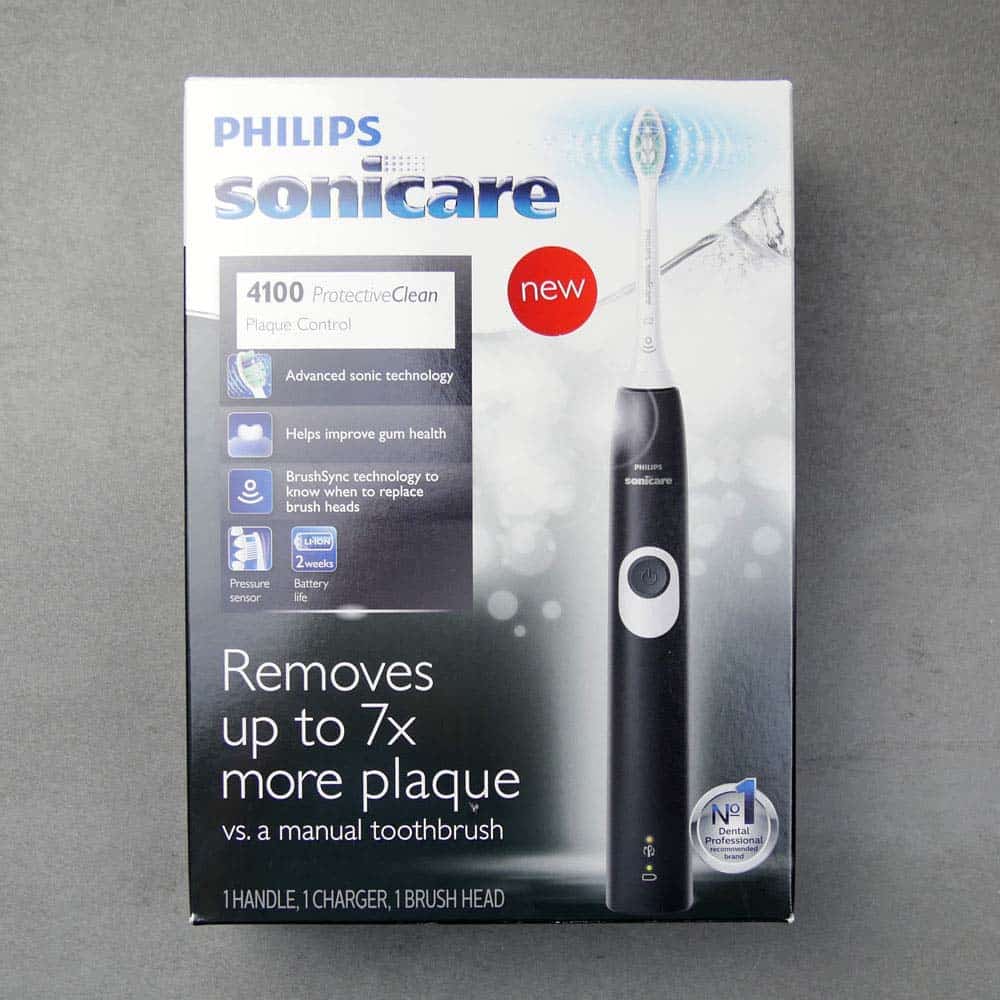
Whilst I am sure, the box could be made smaller, it is made of cardboard as is the inner tray that holds the brush, charger and brush head.
It would be nice if these were not wrapped in the plastic bags like they are, but at least cardboard is recyclable, unlike the polystyrene packaging Oral-B uses.
The brush is made up of 2 key parts, the handle, and the detachable brush head.
The handle is rounded in its shape and has the fairly typical electric toothbrush look to it.
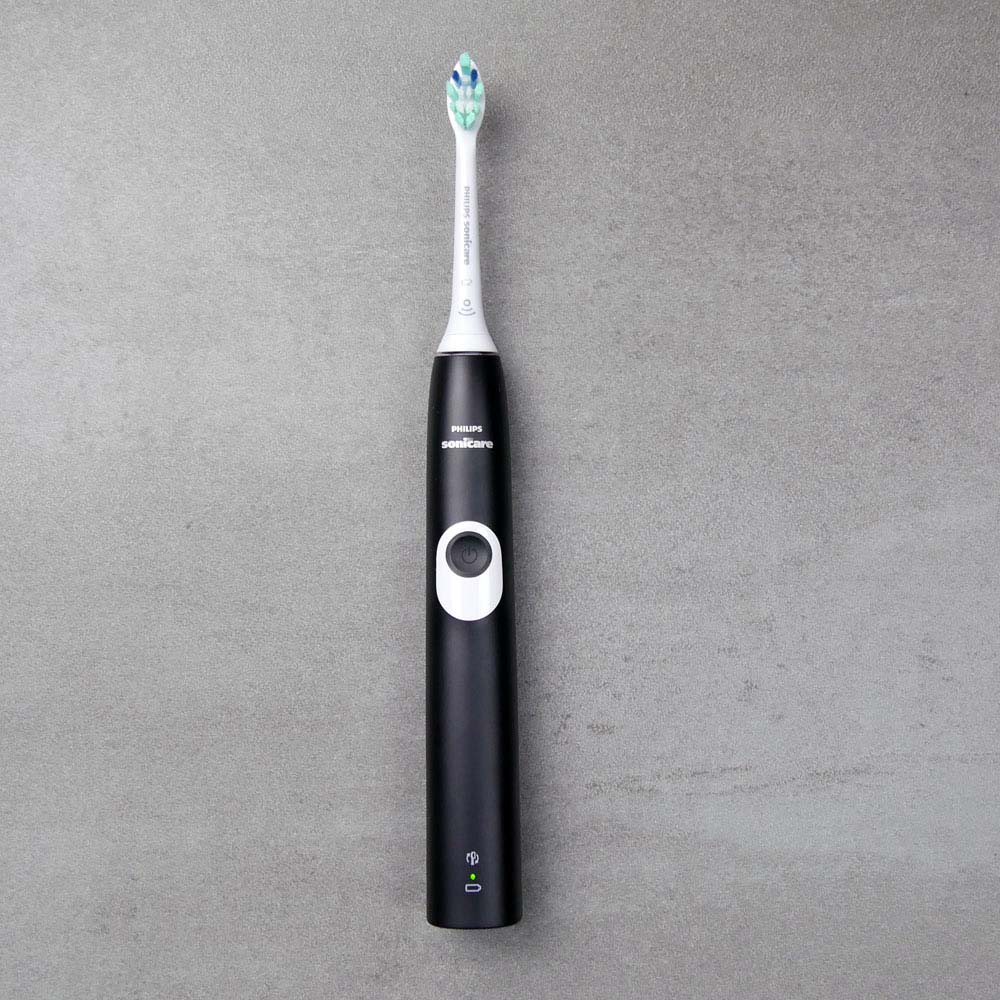
The finish of the plastic has a matt feel rather than the quite common glossy ehite you see.
Despite the minimal gripping points, it feels like you can hold the brush quite securely.
It would be nice if there were a few strategically placed pieces of rubber to grip onto, but this may detract from the clean design.
The 4100 is available in 2 different color options.
There is the black and white that you see in the hands on images as well as a white and mint.
On the black and white color option that I have been testing, the majority of the handle is black, whilst the panel around the power button is white. The brush head supplied is white in color too.
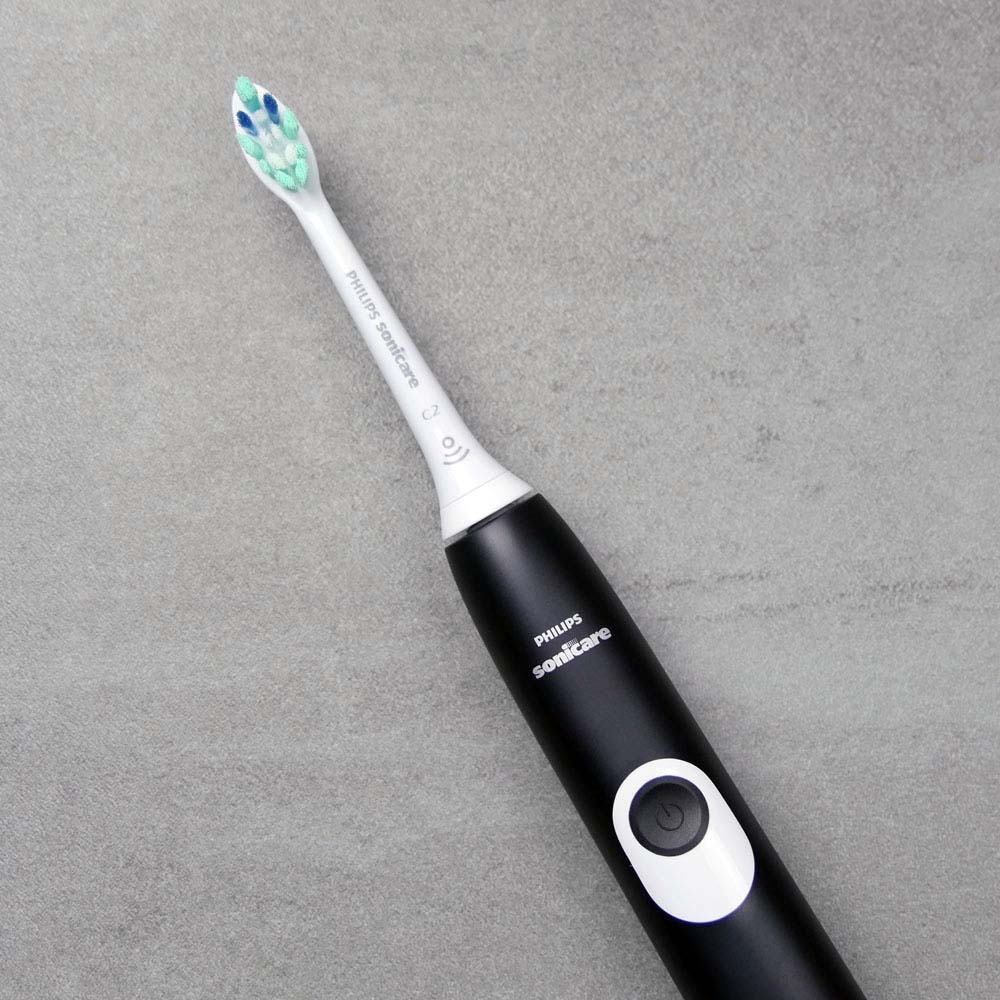
With the white and mint, the handle is all white, with the panel around the power button being Mint.
Personal opinion, but I would have quite liked it if the brush head with the black colored model was black too. Sonicare do make them.
If you are a bit picky like me, you can always buy the black colored brush heads.
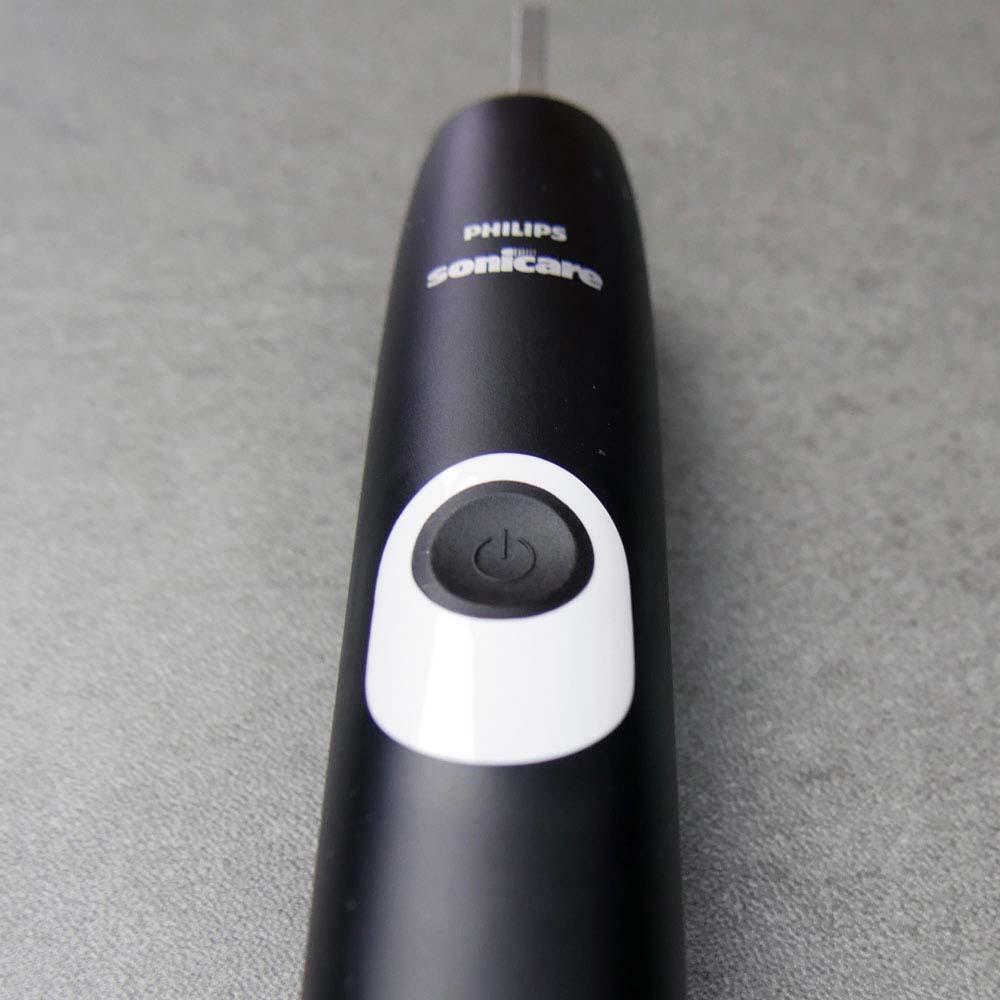
To be fair the black and white color combo works.
Naturally, the white handle comes with a white brush head.
A neat touch is that the charging stand with this black model was black too. Most of the time the charging stand is white.
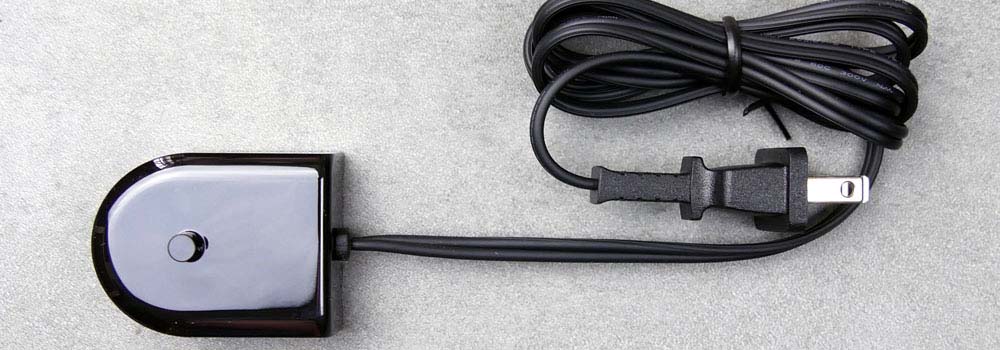
If the handle and the stand are black tough, why not the brush head?!
On the front of the handle, at the top, is the Philips Sonicare logo.
Sitting roughly a third of the way down the handle is the round power button.
A power symbol is embossed onto the concave rubber button and makes for a natural place to rest the thumb.
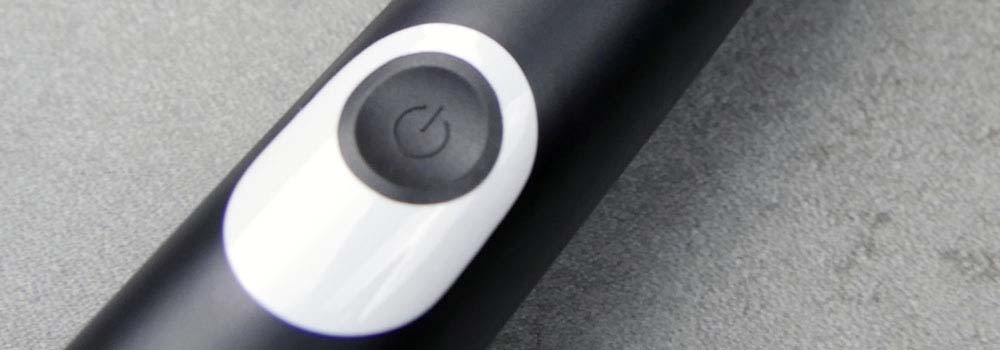
The concave button is relatively easy to press with a bit of feedback.
Surrounding the power button is the color accented panel.
The remainder of the front is smooth to the touch and free of any icons until you you get almost to the bottom.
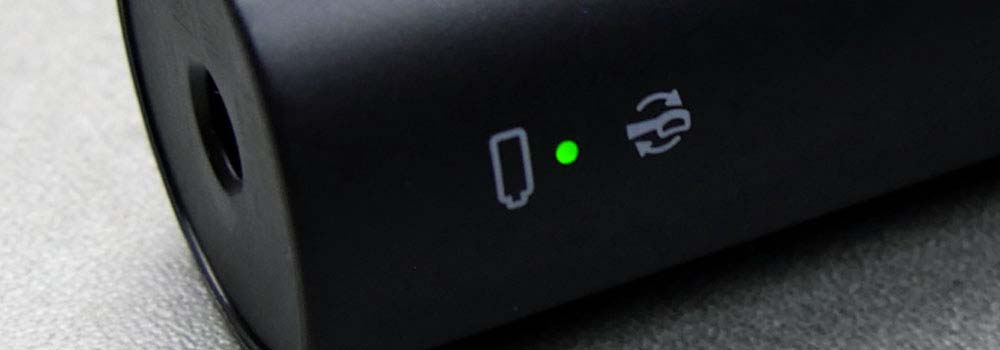
First sits the BrushSync LED and symbol below it and the battery LED and symbol below that.
The back of the handle is smooth to the touch. No ridges or extra grips, with the exception of a little protrusion at the bottom of the handle.
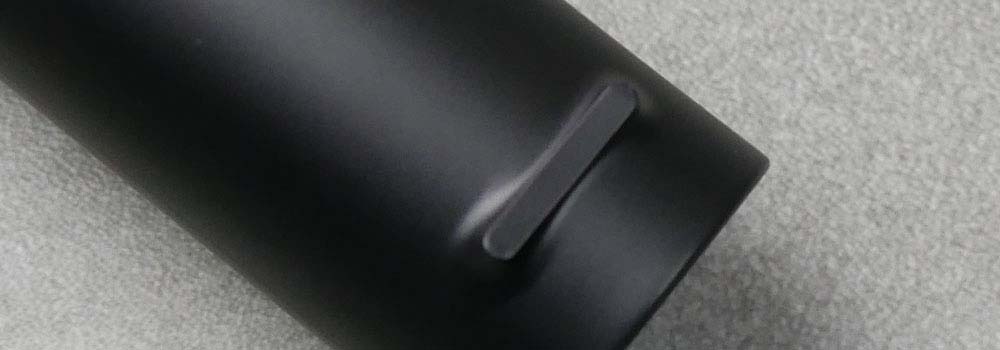
It seems a bit out of place and not immediately obvious what it is for. But, lay the brush on a flat surface, and this raised molding stops the brush rolling about. Genius!
On the base of the brush handle is a recess into which the prong on the charging stand fits.
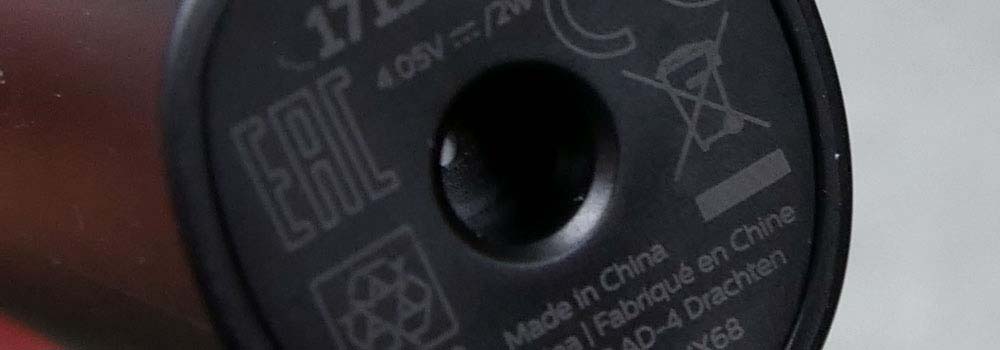
The brush will sit upright on a flat surface and does too sit upright on the charging stand.
At the top of the brush handle is the metal shaft that the brush head connect to. This metal shaft feeds into the motor sealed inside the handle.
Analyze the brush side on and you will see how the brush head fits on at a very slight angle.
Slight it might well be, but it helps angle the brush head for a better reach towards the back of the mouth. A subtle, but important design feature that enhances the overall usability.
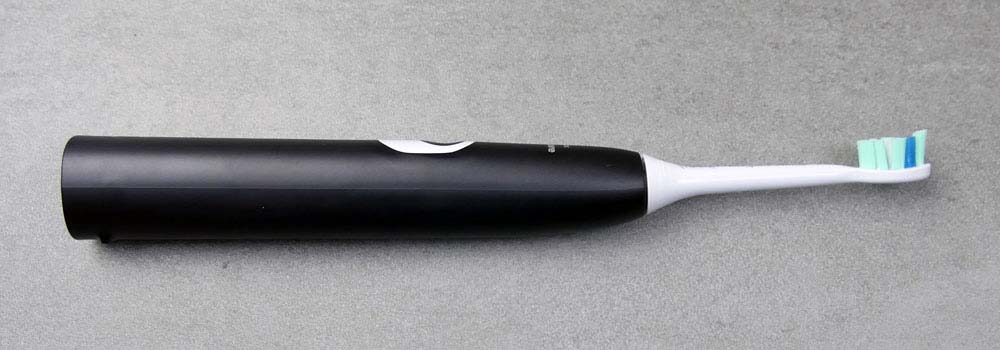
You might notice, there is no icon or LED for the cleaning mode on this brush.
This is because the brush offers just 1 cleaning mode, so really there is no need. If you want to know more about other cleaning modes Sonicare offers on different brushes, see this post.
You simply press the power button once to turn the brush on. Press and hold it for a couple of seconds, if you want to turn the brush off before the cleaning time has elapsed.
As the power button is pressed, it activates the built in timer.
This timer runs for 2 minutes, which is the dentist recommended cleaning time.
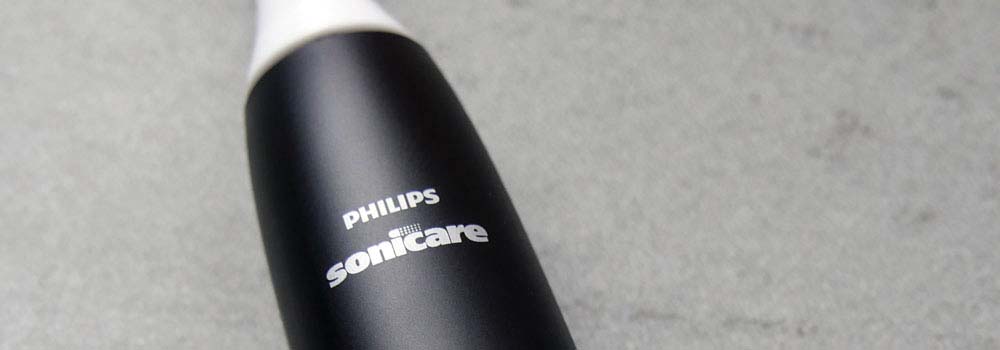
At the end of the 2 minutes, the brush actually turns itself off. This is not something all brushes do, but it is a feature that I like very much.
Not only does it make it clear that the 2 minutes is up, but it helps save battery power too.
Should you want to brush for longer, you will need to power the brush back on.
The 2 minute timer is very useful, but what takes the timer to the next level is the pacer that is also built-in.
The pacer activates at 30 second intervals, by pausing the brush motor briefly.
This pause alerts you, via the change in brush sound and the lack of movement in the brush head, that it is time to change quadrant.
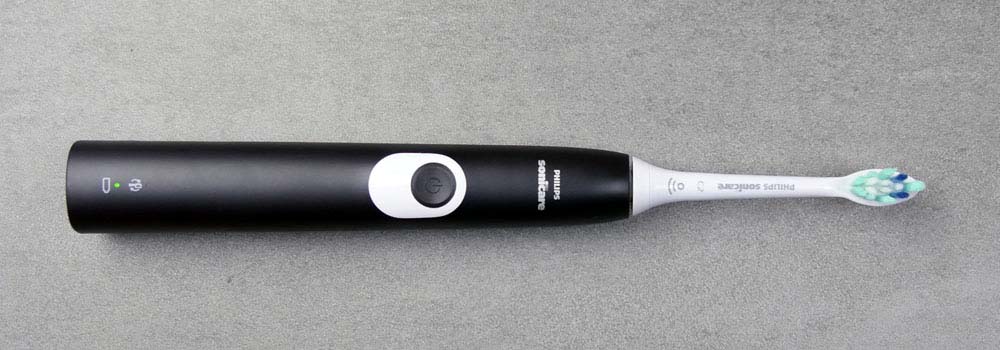
If you are not familiar with the quadpacing setup built into the 4100, allow me to explain.
Whilst dentists recommend 2 minutes of cleaning twice a day, what this does not help with is ensuring you and I brush our teeth evenly. This is where the pacer comes in.
The idea is that you break the mouth up into 4 sections. Upper right, upper left, lower right, and lower left.
You spend 30 seconds cleaning each section, that way over the 120 seconds (2 minutes) of brushing time, you will give a relatively even clean to the teeth and gums.
The pacer acts as an alert to you, to change quadrant as you brush to ensure this even clean.
Of course you don’t have to follow it, but it is good practice.
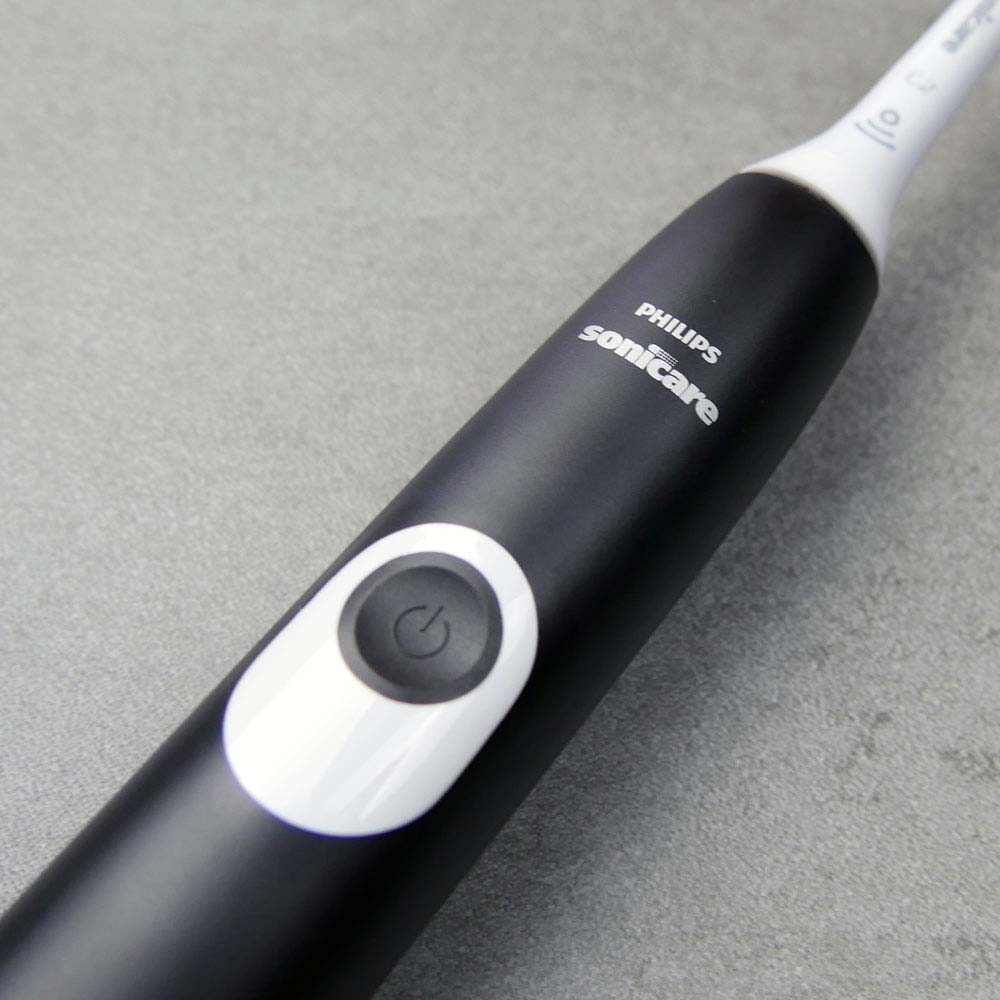
Spending 2 minutes cleaning just the front teeth or just your top teeth is better than nothing but isn’t great for your oral health.
Therefore the 2 minute timer and 30 second pacer are 2 excellent additions to this handle and what I consider core features of an electric toothbrush.
Be aware too, that there is a particular technique with cleaning the teeth. The brush head should be held at a 45 degree angle to the teeth. Refer to the documentation Sonicare include in the box to find out more.
Clean mode is the name given to the only cleaning mode available on this brush.
It makes use of the full power of the motor that is built into the brush handle.
Offering 62,000 movements per minute, the bristles of the brush head move rapidly over the surface of the teeth and gums to dislodge bacteria, plaque, and food debris.
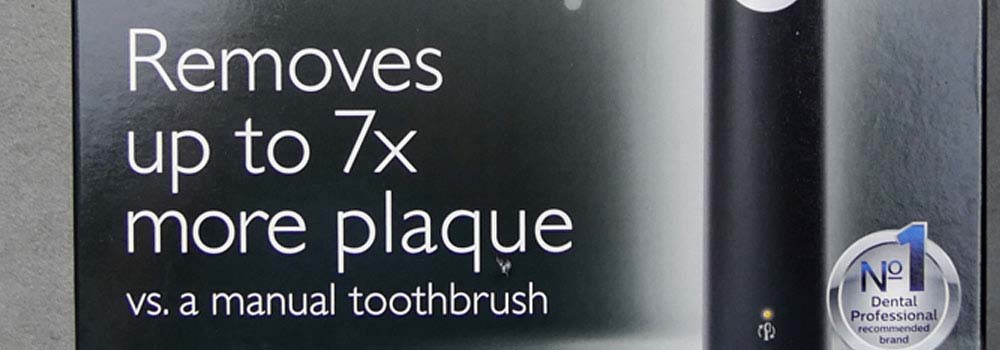
Whilst some might wish for additional modes, perhaps a more gentle sensitive or gum care mode, there is something quite appealing about the simplicity of just 1 mode that works for most users.
The 4100 comes with the C2 Optimal Plaque Control brush head supplied.
This is are just 1 style from a range available from Sonicare.
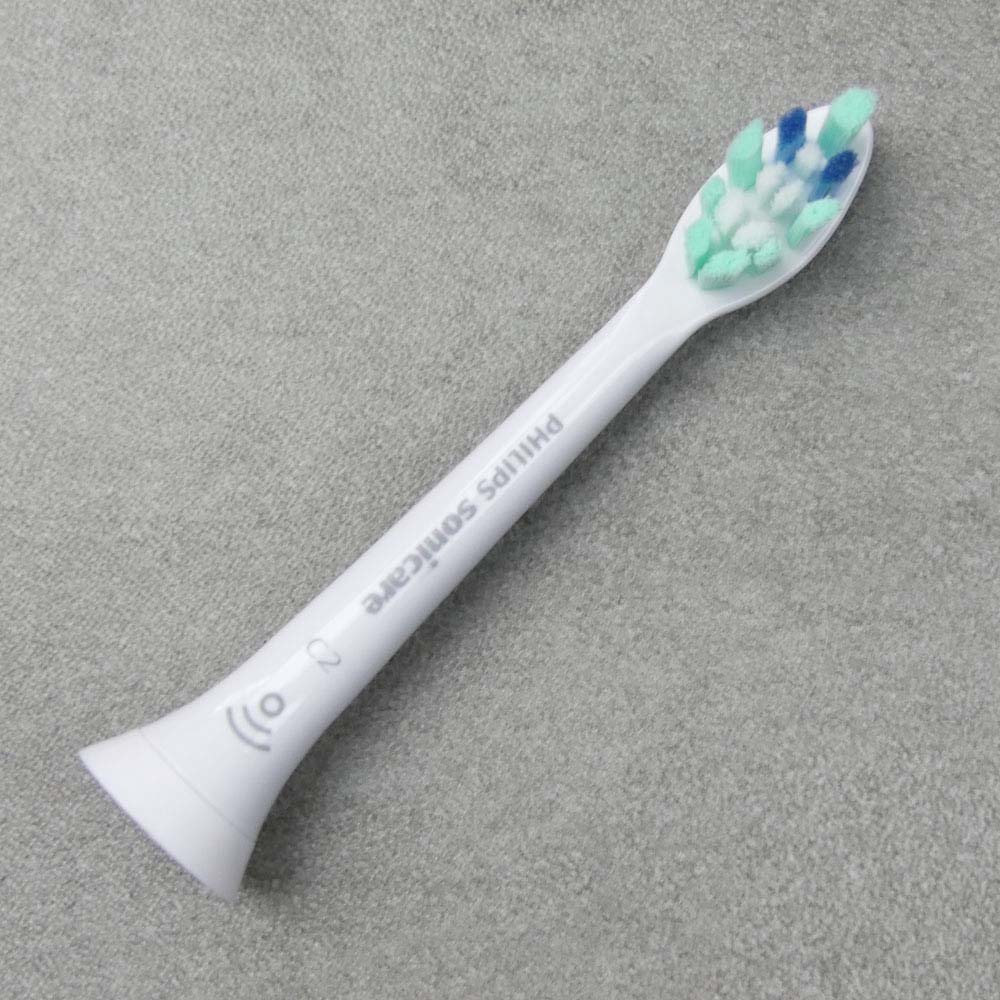
The styles of heads are:
- I Intercare
- Deep in between teeth cleaning, removing upo to 7x more plaque. Idea for those with increased periodontal disease.
- C2 Optimal Plaque Control
- Up to 7x more plaque removal. Ideal for excessive plaque and tartar build-up on tooth surface.
- G2 Optimal Gum Care
- Helps improve gum health with 6x more plaque removal. Ideal for excessive plaque and tartar build-up at the gumline.
- W DiamondClean
- Helps whiten teeth in just 1 week and maintain the white teeth achieved after cosmetic whitening procedures. Capable of 7 times more plaque removal than a manual toothbrush.
- C3 Premium Plaque Control
- Deepest clean with flexible sides and unique bristle pattern. 4 times more surface contact.
- G3 Premium Gum Care
- Absorbs excess cleaning pressure to protect the gums. 2 times more surface contact.
- W3 Premium White
- Helps whiten teeth in just 3 days by removing plaque and surface stains. 4 times more surface contact.
It is these premium brush heads that offer another of the ProteciveClean’s clever features.
The 4100 has something called ‘BrushSync’. Despite the name of this feature perhaps being a bit vague, what it actually does is really quite clever, it reminds you when to replace your brush head.
Inside the brush head is a small microchip.
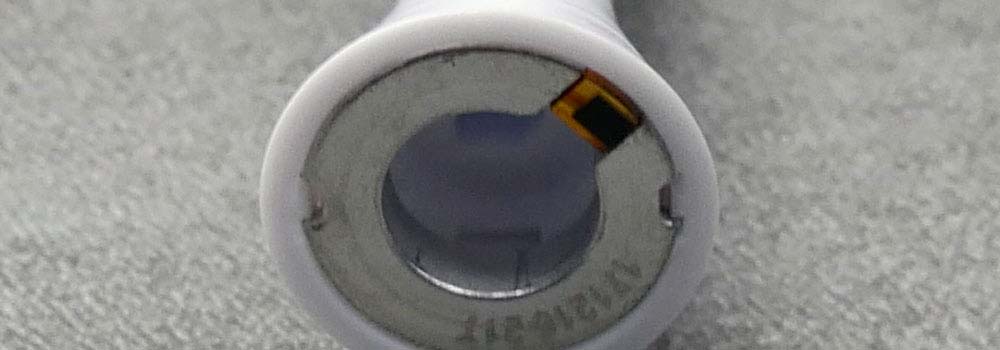
When the brush head is fitted to the brush handle, the chip is detected and the warning light will flash 3 times. This acts as confirmation that the handle has detected the head and that the electronics inside the handle will now keep track of it.
As you use the brush head, the handle continues to track how often it has been used.
The handle knows that the brush head should be replaced every 3 months, so once the handle detects that the brush head has been used for this amount of time, the ‘BrushSync’ LED on the brush handle will light up an Amber/Orange color to tell you it is time to change the brush head.
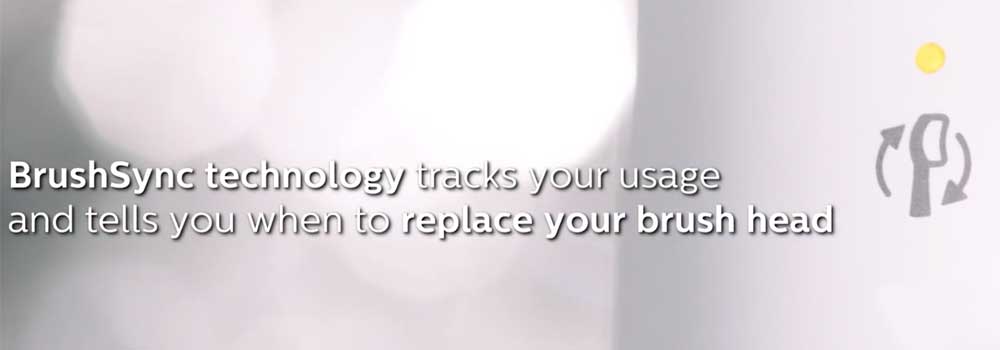
Our own research found that 30% of people don’t change their brush heads every 3 months.
Using a brush head for longer than 3 months can potentially have negative effects on the teeth and gums, so such an alert helps reduce the chances of this.
This is a very neat touch and shows how technology can be used in a positive way to better the nations oral health.
But, the brush is cleverer still.
If it detects you have brushed 3 times a day every day or brushed with more pressure, it will activate the BrushSync alert system sooner, as the bristles will have worn out sooner than the typical 3 month time period.
By the same token, it will delay alerting you to replace the brush head. If you used that head just once a day over 3 months, it would not tell you to replace it until it had been used for an equivalent to 4 minutes a day for 3 months.
All pretty impressive stuff hey?!
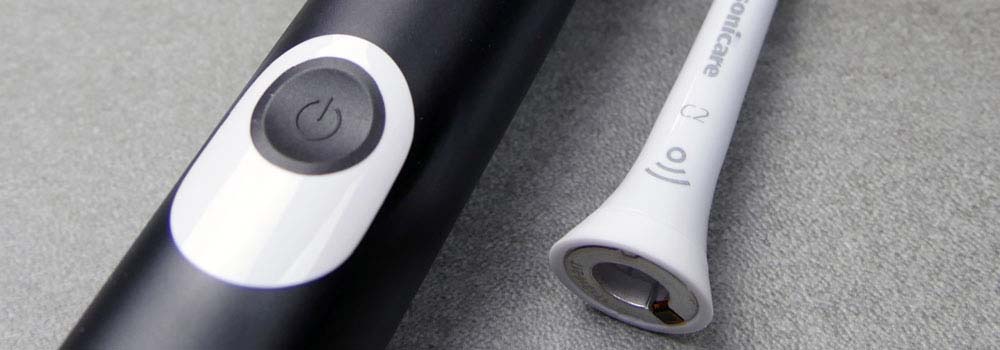
When you do replace the head, the process is simple. Each brush head simply pushes on and pulls off of the brush handle.
These smarter brush heads do (at the time of review) come with a price premium over the standard (microchip free) heads people are more familiar with.
Prices vary from one store to another. I have found them as low as $8 per head, but as high as $15.
An average price is around $12, which is admittedly $3 less than when these were first introduced in 2017.
In a couple of years, I expect the price will have dropped even further.
A normal brush head for a Sonicare electric toothbrush is on average $8.
So the takeaway here is to shop smart when it comes to the heads you want to use on your ProtectiveClean 4100. We cover brush heads in more detail in our guide to Sonicare brush heads.
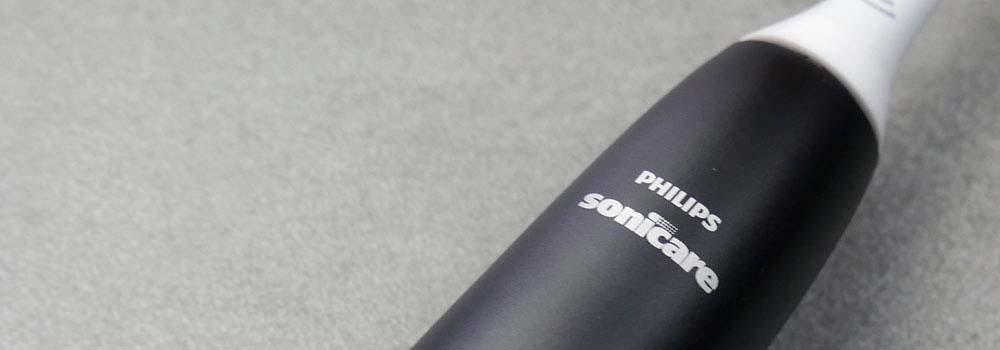
It is perfectly possible to use a non-smart brush head on the 4100 as it is perfectly fine to use a smart brush head on a handle that does not offer BrushSync technology. But, do be aware, the BrushSync will only work when a compatible head is used on a compatible handle.
The ‘standard’ heads come in 6 different styles. They are:
- DiamondClean
- AdaptiveClean
- InterCare
- ProResults
- ProResults Gum Health
- Sensitive
It is worth noting that although the ProtectiveClean 4100 offers the alert to change the brush head, all of the heads Sonicare produce have fading indicator bristles.
These essentially act as a reminder to you as the BrushSync does.
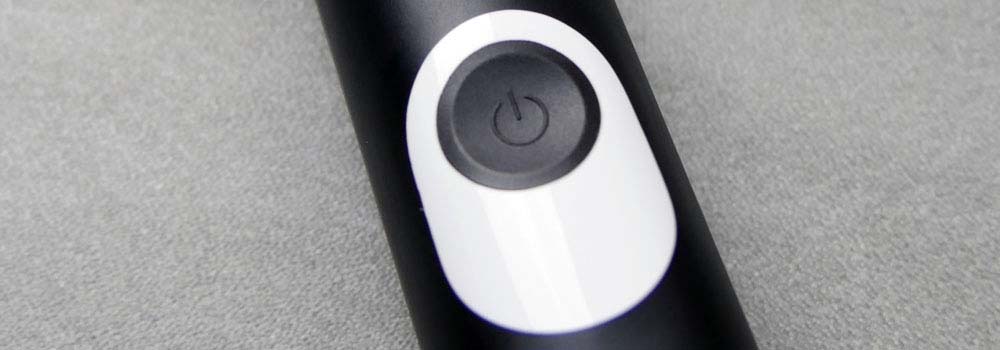
As the heads are used, the blue bristles fade to a very pale almost white/translucent color. When they are this color, it is time to change the head.
You can be assured that Sonicare heads are made to a high standard, and each bristle is rounded at the tip to avoid doing any damage to the teeth and gums.
Bristles need only skim the surface of the teeth. Lots of force is not required to brush the teeth clean.
Brushing too hard over long periods of time can wear out brush heads but also cause gum recession and damage to the tooth enamel.
This then is why the 4100 has a pressure sensor built-in.
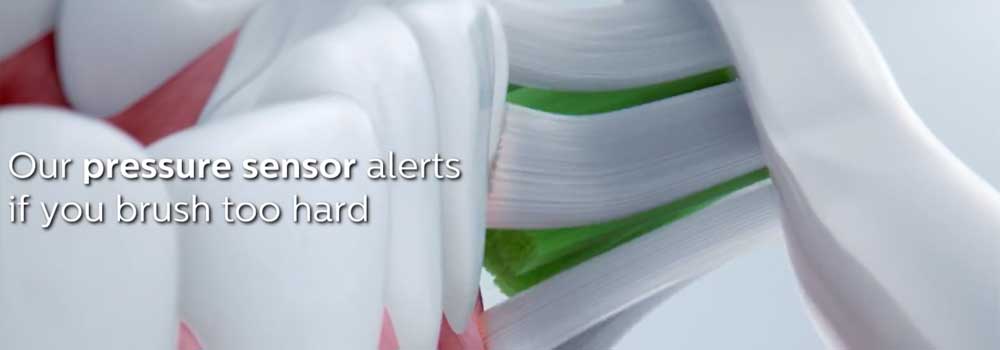
The handle vibrates to alert you when too much pressure is being applied, the brushing sensation and sound changes too.
The BrushSync replacement reminder LED flashes Amber when the sensor is activated. Given its position, it is not the easiest to see.
It does not have the large visible pressure sensor like the the Oral-B Pro 1500 and 3000 and Sonicare’s own DiamondClean Smart.
Personally I do think the light it more obvious, particularly when most of us tend to brush in front of a mirror. Sadly, the flashing Amber light is on the wrong side of the handle for you to really notice, but you should feel the change in brushing sensation.
However, the vibration is strong enough to make you aware it has been activated.
To stop the pressure sensor, just relieve the pressure applied to the teeth.
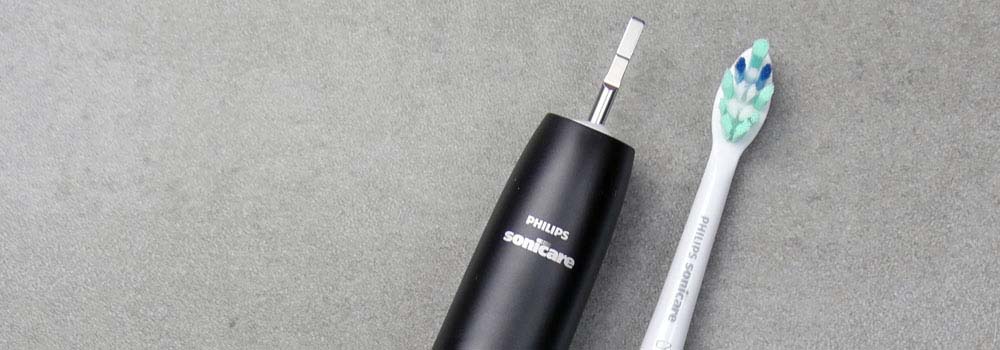
The vibration will kick in every time too much pressure is applied.
Within a few days, you will get used to how much pressure is appropriate.
This is great for new users of electric toothbrushes, as is another feature Sonicare have built-in,
EasyStart is a system that gently increases the power over the first 14 brushings to help you get used to brushing with the Philips Sonicare.
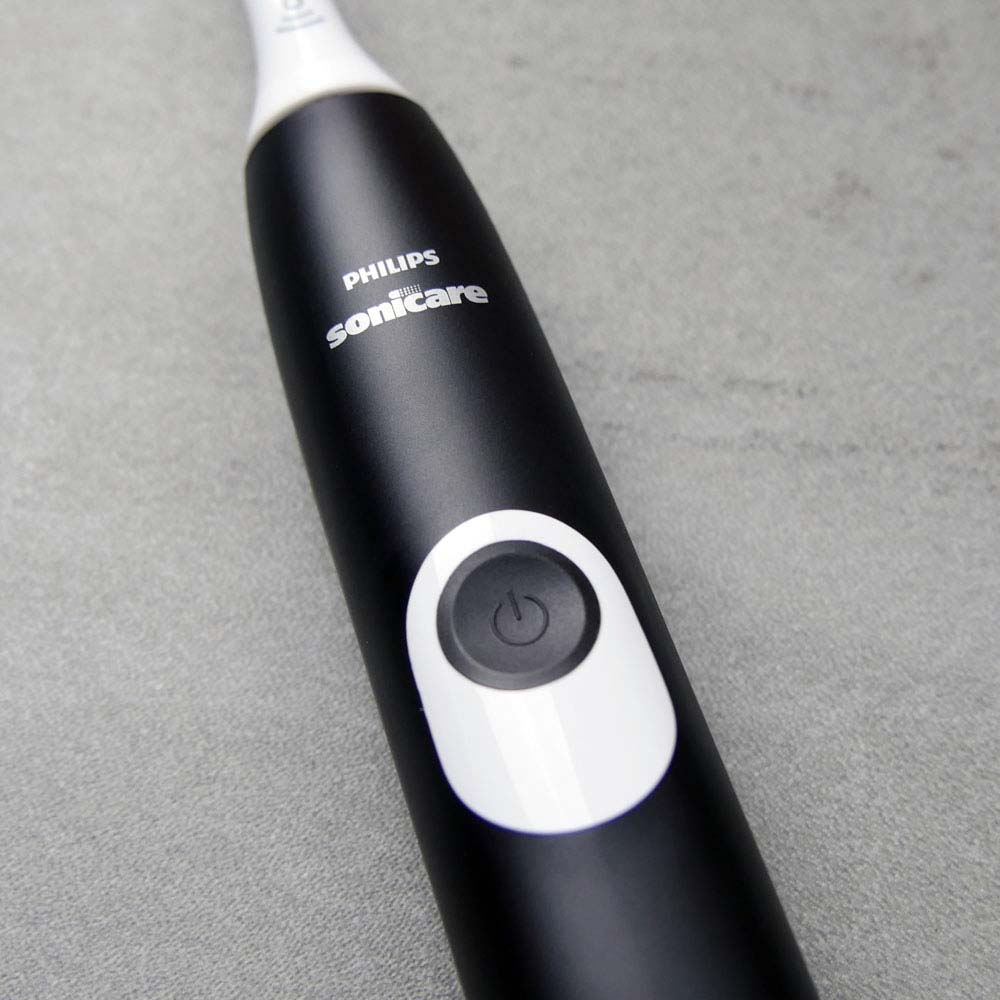
A simple, but innovative touch that shows an extra level of attention and care for the first time electric toothbrush users.
If you are not used to the power of an electric toothbrush, the full 62,000 movements per minute (31,000 brush strokes) can seem quite intense on first use. EasyStart eases you in.
If you desire, it is possible to turn off EasyStart as well as the pressure sensor and the brush head replacement reminder. Directions on how to do this are included in the FAQ’s towards the end of this review.
The clean provided by the 4100 is excellent.
After every use, my mouth felt refreshed. I can’t really fault it.
The smaller round brush heads found on Oral-B models can be a little easier to move to the back teeth, in particular, the Sonicare heads are a little larger.
Those with smaller mouths and cramped teeth might find Oral-B’s brushes to be better suited to them.
Inside the handle, is the rechargeable Lithium-Ion battery that offers 2 weeks usage between charges or so Sonicare claim. I actually managed 5 weeks!
When the power is low, the brush will indicate this through the battery indicator LED. Just pop it on the provided charging stand for up to 24 hours to fully recharge.
Designed to resist water, toothpaste, and saliva, the handle of the 4100 is not designed to be used in the shower or the bath. A quick rinse of the handle is fine, but don’t go immersing it in water.
The handle feels robust and will generally take a few knocks in its life and I have no immediate concerns about the handles reliability.
Sonicare does offer a 2 year warranty that covers any mechanical or workmanship faults, but not user damage. For your own benefit, go register it shortly after purchase and get an extra 6 months for free.
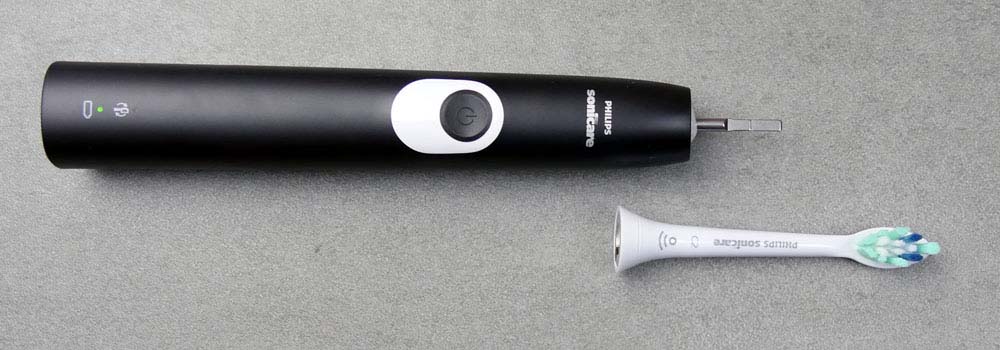
Whilst 1 brush head and a charging stand are all you need to get you up and running, it would be nice if there was a little extra box contents, maybe another brush head or a travel case.
Perhaps I am being a bit picky given the price, but it would have been a nice touch.
If you want a travel case, which is admittedly handy for regular travelers, you will need to buy one separately or choose a model like the Sonicare ProtectiveClean 6100 that comes with one in the box.
The 6100 does provide more cleaning modes for those who desire it. Seeing as many of us end up sticking with the default mode, there little need upgrading to this model unless you feel you would benefit from alternative cleaning modes.
Those with particularly sensitive teeth, who like a less powerful and softer brushing experience might be tempted by the 6100, even if it costs more.
Oral-B’s Pro 1500 is very similarly featured and priced to the 4100 but comes with a Sensitive cleaning mode, so this is an option too.
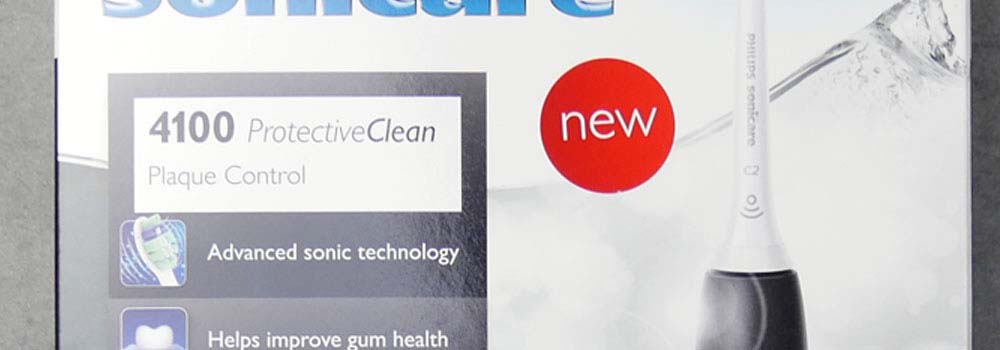
Having used the ProtectiveClean 4100 for a few weeks and compared it to many other models I have used, I have to say I am really hard pushed to find fault.
It cleans the teeth well, has all the core features of an electric toothbrush, plus a few more for added benefit. Sonicare have made a fantastic toothbrush that has too gotten the backing of the American Dental Association.
Summary of design, usability, clean & general use
Battery life
The importance that you place on battery life may well be different to me.
For a large number of us, we brush our teeth at home when we are near to a power source, so we don’t need to worry about how long the battery really lasts because it is so easy to recharge it.
However, there are still a good few people who travel regularly and want to do so with as little luggage as possible.
So, if you are off on a 10 day trip to see relatives in another state, it would be great if you could leave the charger at home.
The Sonicare 4100 offers 14 days of battery life or so Sonicare claim.
That is a total of 56 minutes usage time, based on 2 cleans per day of 2 minutes in length.
This would be acceptable, but my hands-on testing managed 5 weeks, 2.5 times what Sonicare suggested.
I can’t guarantee you will get quite the same performance and I am surprised I achieved as long as I did, but wow!
Safe to say 2 weeks is the absolute minimum!
The white colored stand allows the brush to sit on top of it. A prong on the stand fits into the recess on the base of the brush handle.
It can take up to 24 hours to charge the handle fully.
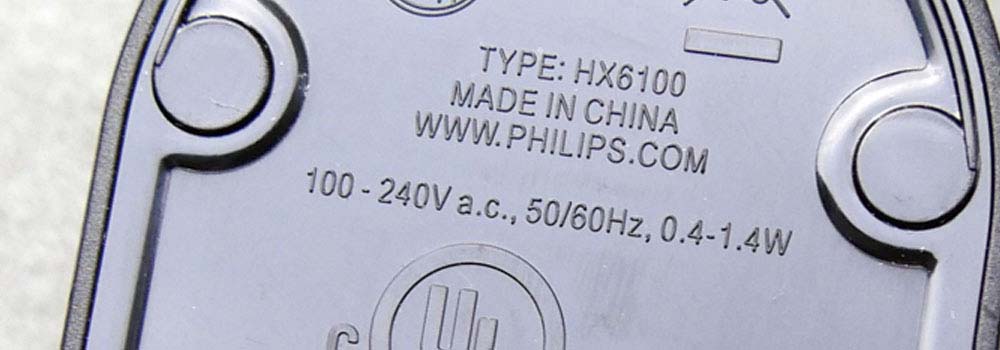
A US power adapter is wired into the charging stand, but it does support 100-240v.
What this means is that you can actually travel to other countries, like those in Europe and use this charging stand. You will require a plug adapter only and not a voltage adapter.
Towards the bottom of the brush handle, on the front is a battery/charging icon.
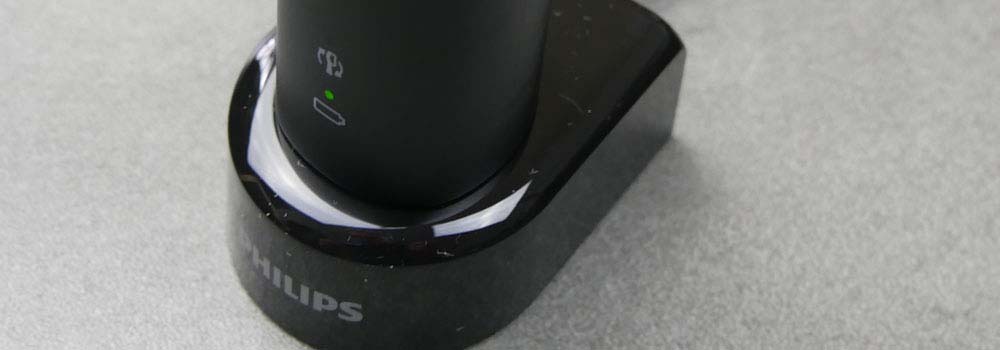
The way in which it flashes and the color it is lit tells you how much power is in the Lithium battery.
A solid green LED means a full battery.
A flashing green LED means a medium battery.
A flashing amber LED and three beeps mean a low battery.
A flashing amber LED and five beeps mean no brushing sessions left, you need to charge the toothbrush.
It would be nice if the indicator was a bit more accurate, like a smartphone battery that gives you a percentage (%), it can feel a bit vague at times, but no brush offers such.
Once placed on the charging stand, the charger will emit 2 short beeps to confirm that the handle is placed properly.
The flashing light of the battery level indicator shows that the toothbrush is charging. When the handle is fully charged, the battery light shows goes a solid green for 30 seconds and switches off.
Generally speaking, it is ok to leave the brush sat on the charging stand when not in use. It is perfectly fine to keep the battery topped up,
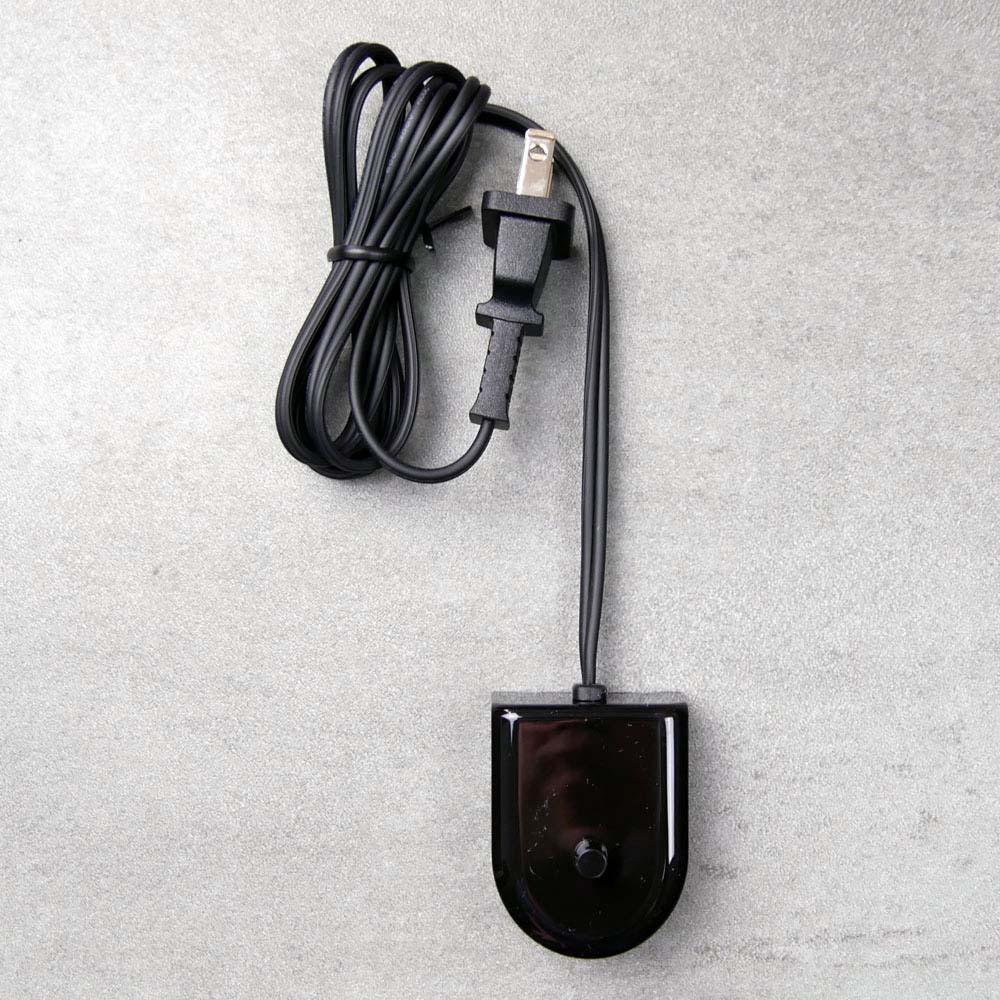
But, a good practice is to let it run down a little and not constantly be fully charged. To avoid doing any potential long term damage to the battery, keep it unplugged unless it needs charging.
The Lithium-Ion (Li-Ion) cell sealed inside the handle is not user removable. It is more efficient and reliable than the Nickel Metal Hydride (NiMH) cells that have been used in many toothbrushes in the past.
A small but significant feature built into the brush which allows this usage time is the automatic power off. At the end of a cleaning cycle, the brush turns itself off to signal the end of the clean and conserve power. Oral-B models do not do this.
Summary of battery life
Price & where to buy
Given that the Sonicare 4100 does not have the most features of an electric toothbrush today, nor does it have lots of items in the box, this brush is far from the most expensive available.
The suggested sale price is $69.99.
When you compare to other models available, this is pretty much on par, particularly when most actually sell a little under the suggested sale price.
At the time of review, just a few weeks after the 4100 launched, the actual price you can buy the brush for is around $50, so a $20 saving.
In fact, 4 major retailers were priced within just $5 of each other.
We have listed a few buying options at the start of this article.
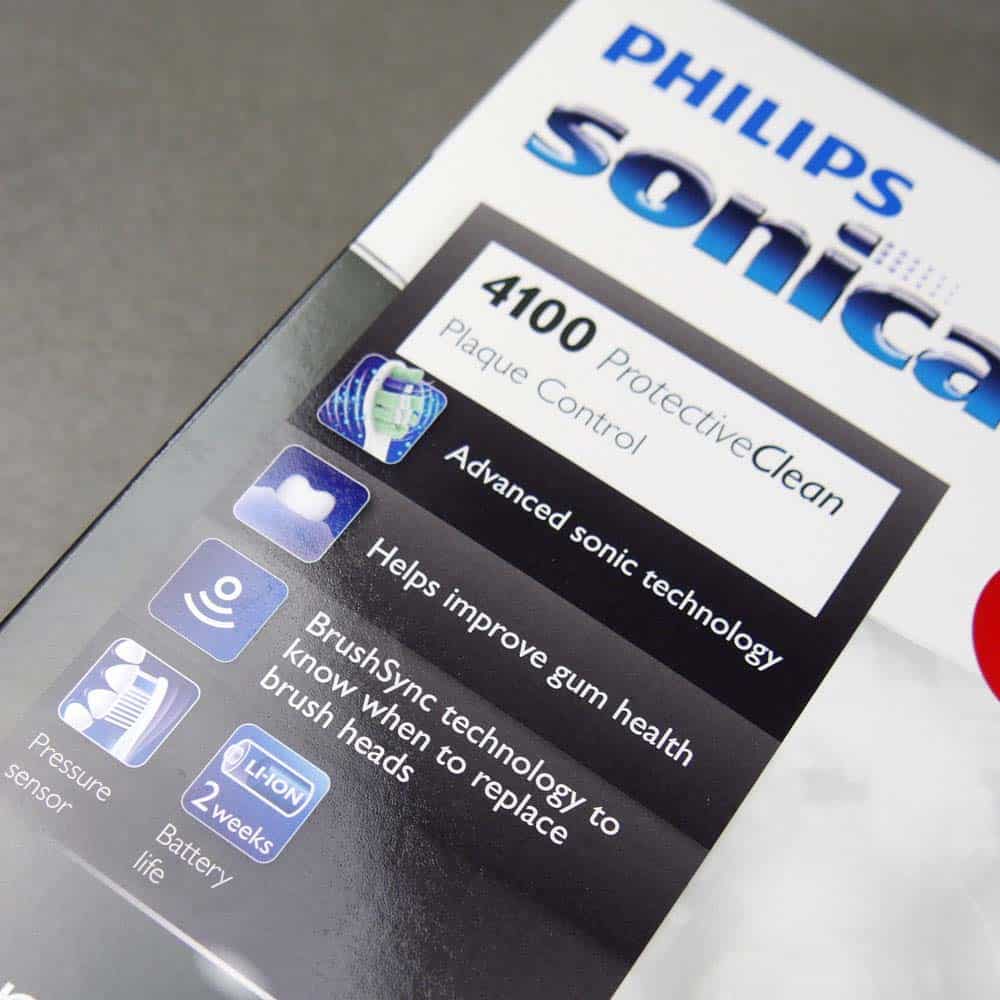
This makes the 4100 very competitively priced.
As you probably expect, prices are always subject to change and some retailers adjust their prices and run offers more frequently than others.
Prior to the 4100 being launched, the Sonicare 2 Series and Oral-B Pro 1000 were the best example of a great electric toothbrush for the money.
Typically these 2 brushes sell between $40-50.
These 2 brushes are still available at the time of writing, but I suspect the 2 Series will be phased out.
At around $50, given the brush is newer and offers neat features like the brush head reminder system, it is a great value buy.
Naturally, brush heads require replacement. Advice is to replace each head every 3 months. Of course, the 4100 will remind you to do this.
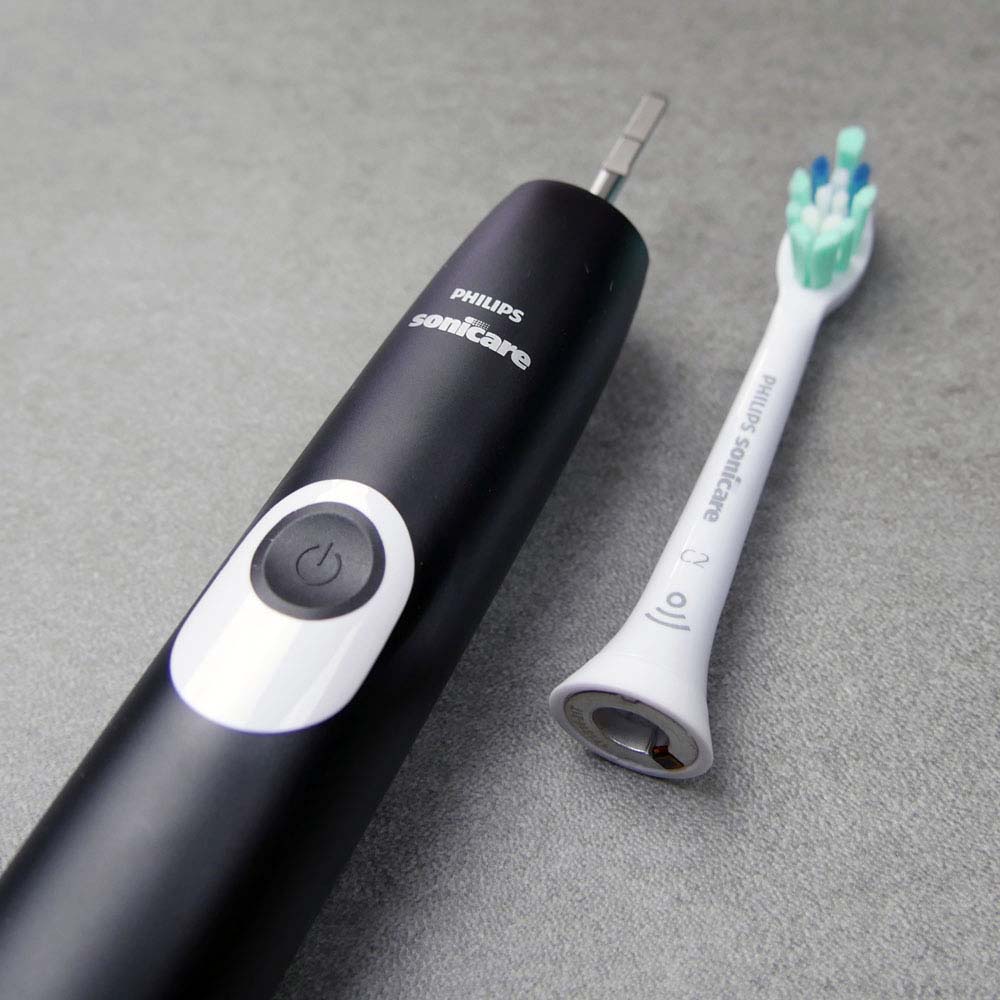
The technology required for this reminder system has impacted the cost of the brush heads.
A single ‘BrushSync’ compatible head can cost as much as $15 each or as little as $8 per head.
As an average, you can expect to pay $12.
You need to be a savvy shopper here. It is possible to save quite a bit of money on the heads if you can.
In time, the cost will come down further I am sure. In fact, there have already been a few dollars knocked off the average price since these heads were first introduced in 2017 with the DiamondClean Smart.
You could opt for the official Sonicare brush heads that are not ‘BrushSync’ compatible, but that kind of defeats the point.
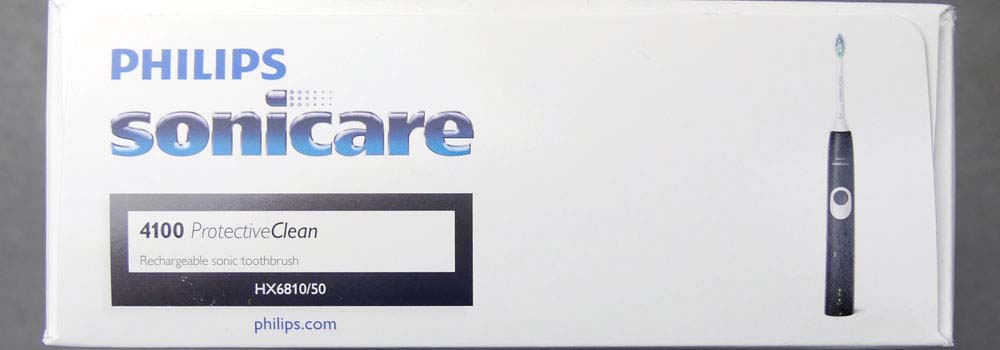
A typical working life of an electric toothbrush is normally 3-5 years. Many will, in fact, last a lot longer, with good care.
To try and give some sort of gauge for overall ownership cost, here at Electric Teeth, we like to price the brush over a 3 year period to give a benchmark and allow comparison to other brushes.
There is the initial purchase price of approximately $50 for the brush. Add in the cost of replacement brush heads at approximately $12 each and there is an additional cost of $132 over 3 years.
The total cost, therefore, comes to $182 or $0.17 per day.
If you are able to pick up a deal on the brush heads at the lower cost of $8 per head, the cost reduces quite significantly.
It would then total $138 or $0.13 per day.
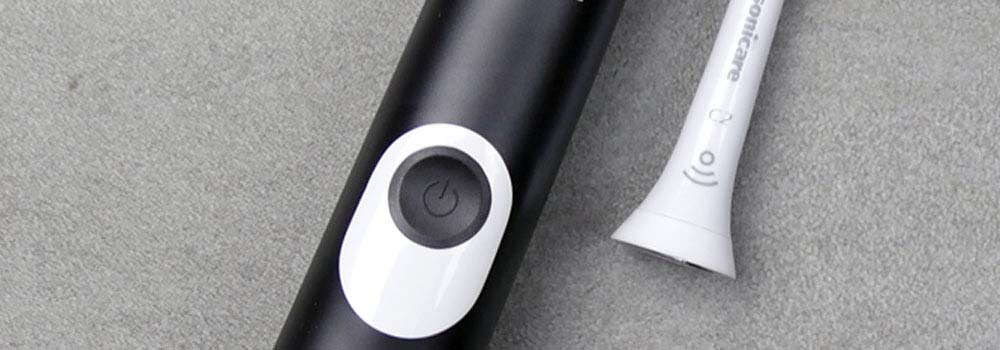
For the sake of comparison, the Oral-B Smart 1500 works out at 11 cents per day, primarily because its brush heads are around $5 each.
You might consider the more premium Sonicare ProtectiveClean 6100 but that comes in at 18 cents per day.
These prices do exclude the cost of water, toothpaste and electric to charge it, but you get a rough idea.
Sharing the brush handle, but switching heads with other users in your household will only help bring the cost down and drive more value from it.
Considering the features, the performance, the box contents, and the comparable brushes, although a touch more expensive than the Oral-B option, I think it still represents great value.
Please note that all prices quoted are approximates and will vary based on location, supplier and time of purchase. These figures were correct at the time of writing and should not be relied upon as hard fact, but used as a guide during your decision process.
Summary of price & where to buy
Reliability & long term use
My hands-on testing does not put the ProtectiveClean through specialist machines that stress test it and expose it to all the elements to find out how and when it will fail.
I use it just like you would, at home and on my travels.
Having handled so many different toothbrushes and having received feedback from readers and other electric toothbrush users, I can often pick up potential faults and build issues that exist.
Sonicare have always had a high standard and the 4100 does not disappoint here.
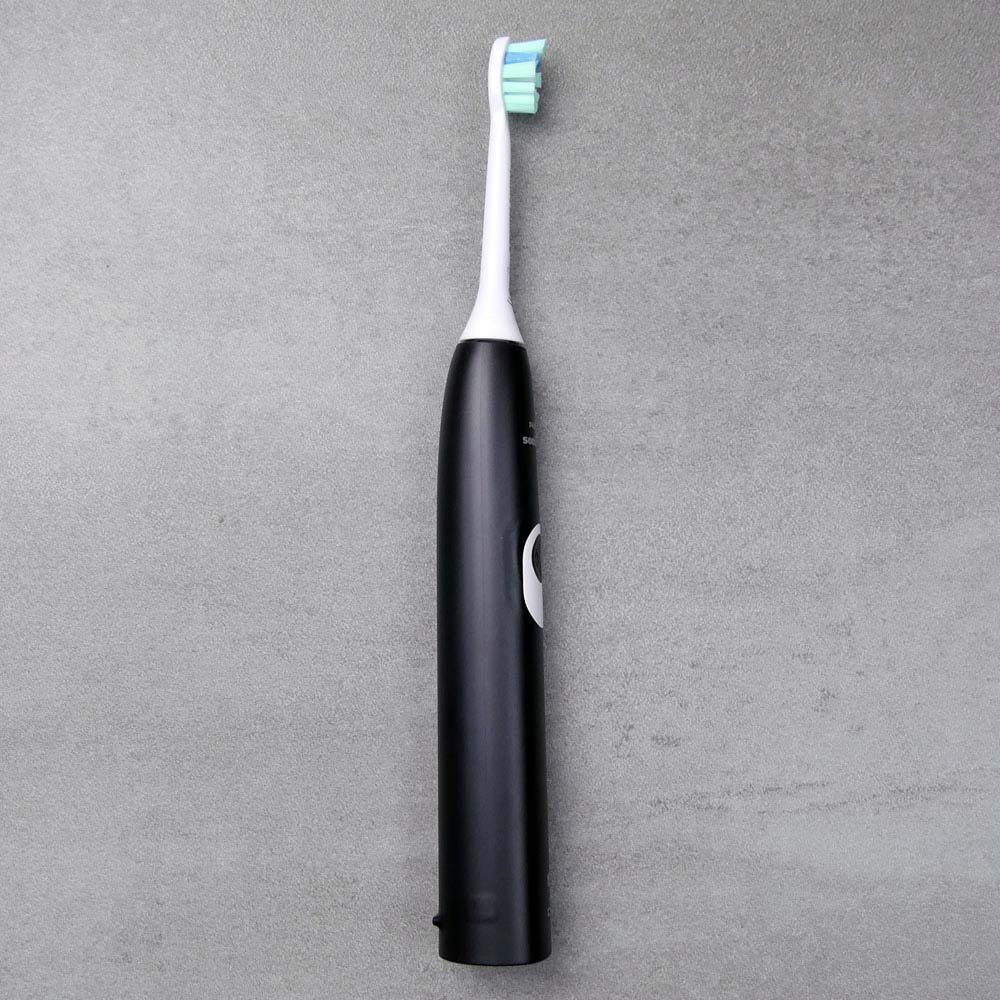
It feels solid and well built-in hand and the construction is spot on.
Naturally being an electric item things can go wrong, but the chances are slim.
Should it fail, the brush comes with a 2 year warranty that can be used to get it repaired or replaced (at Sonicares discretion).
Register it online after purchase and get an extra 6 months extension to that warranty, for free.
I truly believe you can buy this brush in confidence that it will serve you well for many years.
Conclusion
If you want a sonic electric toothbrush, just go and buy the ProtectiveClean 4100, this electric toothbrush is practically faultless.
If you want an electric toothbrush that delivers an excellent clean, has an excellent battery life, is reliable and not bogged down in unnecessary features, then this is it.
Oral-B's Smart 1500 is my ultimate pick. Over a several years of ownership it is more affordable but with comparable features.
Size guide
- Toothbrush height with head - 25cm / 9.8 inches
- Toothbrush height without head - 19cm / 7.4 inches
- Width - 2.8cm / 1.1 inches
- Depth/thickness - 3cm / 1.1 inches
- Weight with head - 130g / 4.6oz
- Weight without head - 125g / 4.3oz
- Package weight - 340g / 12oz
Noise
- 52dB
Country of manufacture
- China
FAQ
How to turn on and off EasyStart
- Put the handle on the plugged-in charger.
- Press and hold the power on/off button while the handle remains on the charger.
- Keep the power on/off button pressed until you hear a single short beep (after 2 seconds).
- Release the power on/off button.
- Triple tone of low-med-high means the EasyStart feature has been activated.
- The brush head replacement light and the battery light will also blink green 3 times in unison to confirm activation.
- Triple tone of high-med-low means the EasyStart feature has been deactivated. The brush head replacement light and the battery light will also blink amber 3 times in unison to confirm deactivation.
How to turn on and off brush head reminder
- Put the handle on the plugged-in charger.
- Press and hold the power on/off button while the handle remains on the charger.
- Keep the power on/off button pressed until you hear a series of two short beeps (after 4-5 seconds).
- Release the power on/off button.
- Triple tone of low-med-high means the Brush head replacement reminder feature has been activated. The brush head replacement light and the battery light will also blink green 3 times in unison to confirm activation.
- Triple tone of high-med-low means the Brush head replacement reminder feature has been deactivated. The brush head replacement light and the battery light will also blink amber 3 times in unison to confirm deactivation.
How to turn on and off pressure sensor
- Put the handle on the plugged-in charger.
- Press and hold the power on/off button while the handle remains on the charger.
- Keep the power on/off button pressed until you hear a series of three short beeps (after 6-7 seconds).
- Release the power on/off button.
- Triple tone of low-med-high means the pressure sensor feature has been activated. The brush head replacement light and the battery light will also blink green 3 times in unison to confirm activation.
- Triple tone of high-med-low means the pressure sensor feature has been deactivated. The brush head replacement light and the battery light will also blink amber 3 times in unison to confirm deactivation.
- If you continue holding the power on/off button after the three short beeps, the activate/deactivate sequence repeats.



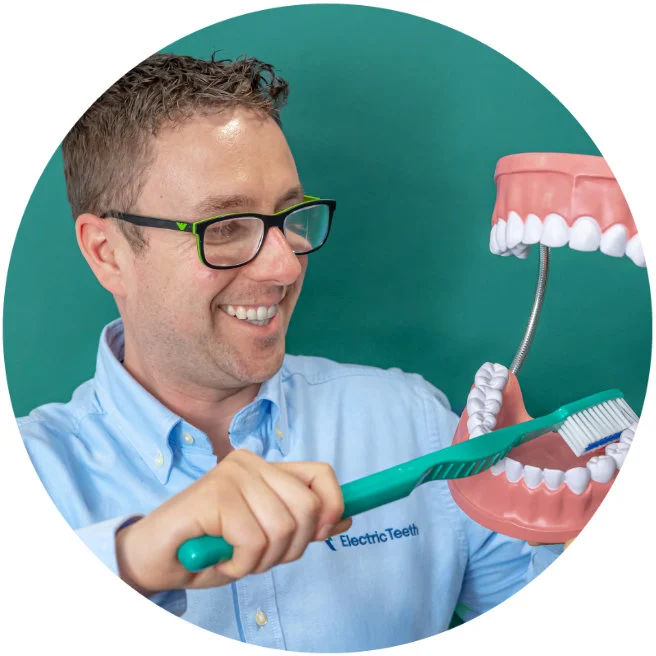
Hello, when you review the new 4100, can you report if the 2 intensities are equal to any of the intensities on the 6100? For example, are they the same as the medium and high, or medium and low? Thank you!
Jon, I purchased a Phillips Sonicare 6100 at Costco today and after a little research I came across a ultrasound power toothbrush. Can you kindly give me your opinion of the ultrasound product? Is this the next generation of power toothbrushes?
Hi Ron.
Although I am aware of Ultrasonic/ultrasound toothbrushes, I have not yet tested any.
There is some evidence to suggest they are beneficial, but from what I have seen, read and understand is that there is limited reason to really consider one over and above a sonic toothbrush like the 6100. Any 'benefits are really outweighed by the cost and product availability. The existing electric toothbrushes are more than good enough when used correctly.
Thank you for your reply
At Amazon, both brand's heads below were displayed for Philips Sonicare toothbrush 4100. Their prices have a big difference:
1. Philips Sonicare HX9023/65 Genuine C2 Optimal Plaque Control Toothbrush Head, 3 Pack, White $24.99($8.33 / 1 Count)
2. Replacement Toothbrush Heads Compatible with Phillips Sonicare Electric Toothbrush 4Pack $9.99($2.50 / 1 Count)
How do you evaluate the cheapest head (4 pack $9.99)?
Thanks
Having done a search on Amazon, I think I have found the pack you are referring to, made by Mailink.
I have not used these to be able to comment. I suspect they do the job.
But there are made by a thrid party and not Philips Sonicare. They will not support BryshSync technology, so you will not get a reminder when they need replacing.
They are a cost effective alternative for sure.
Hi. Looks like oral-b pro 1000 does have a pressure sensor as in their website's page -
https://oralb.com/en-us/oral-b-pro-1000-rechargeable-electric-toothbrush/
The article states that it does not. Not sure when this feature was put into it though..
Hi Kay.
Yes, in truth the Pro 1000 does have a pressure sensor (of sorts).
What makes it slightly tricky and awkward for a user is the way in which it is implemented.
When the pressure sensor is activated on the Pro 1000, there is a slight change in the sound of the toothbrush, the brush head motor slows very slightly and that is it. In fairness, this can have a benefit and can be detected by some. The issue, if I may call it this is that most don't even realize it has been activated. There is no change in the vibration through the handle, the sound change is subtle as is the change in brushing sensation. Therefore it is easily missed.
With the 4100 it is much more noticeable due to the clear difference in vibration pattern in the handle.
Other Oral-B models have a visible pressure sensor built-in which is much easier to detect.
Hi Jon, I recently bought this toothbrush and as it didn’t come with a travel case (I’m a flight attendant) my friend gave me hers - it’s a diamond clean Sonicare case - so a travel case and charger in one! It works on my ProtectiveClean 4100. I didn’t know my toothbrush was even compatible!!!! So cool 😎
Thanks for the feedback Cournety. Glad you have found a solution that works well for you.
I made sure the pressure sensor feature is activated, but when I brush hard I can't really tell any difference in the vibration. Is it a subtle difference?
It should be noticeable. The handle should give a different vibration and the sound should change slightly if you are brushing with too much force.
Re: Easy-Start, I saw in one of the manuals, "Using the Easy-start feature beyond the initial ramp-up period is not recommended and reduces Sonicare's effectiveness in removing plaque." Does that mean that after the first 14 brushings, easy-start de-activates itself and you don't have to do anything? Or do you have to de-activate it after that? Thank you
Hi James.
Yes, after 14 days Easy-Start is automatically deactivated by the toothbrush.
I've never had an electric toothbrush and have a concern about the Sonicare brush. Since it works by using extreme and intense vibration vs. oscillation, is it prone to loosening fillings or crowns? Used regularly, I really don't see how it wouldn't.
Mark,
Thanks for the comment. The use of a Sonicare toothbrush should pose no risk to crowns or fillings. Thousands who have both use a Sonicare toothbrush daily.
What seems very confusing and complicated to me is the part on How to turn on and off EasyStart, Brush Head Reminder and Pressure Sensor. Seems like it would be hard to tell if you activated those or not, just going by the lights and beeps, since it's the same number of beeps and lights for both activating and deactivating. Is it necessary to go through all that, or does the brush come with those already activated?
Hi Lee.
Thanks for the comment. I do see your point, but actually, it isn't as confusing in actual use.
Firstly, I can confirm all of these features come pre-activated (switched-on) out of the box.
So, you don't need to do anything unless you actually want to switch features off.
When you do, the amount of time you press the button for and the number of beeps differ.
Disabling Easy-Start: Keep the power on/off button pressed until you hear a single short beep (after 2 seconds).
Disabling brush head reminder: Keep the power on/off button pressed until you hear a series of two short beeps (after 4-5 seconds).
Disabling: Pressure Sensor: Keep the power on/off button pressed until you hear a series of three short beeps (after 6-7 seconds).
Perhaps the implementation could have been slightly better, but it works.
I have a question regarding some of Sonicare's newer brushes, as I've heard their DiamondClean series of brushes leave you with that "dentist-clean" feel from many reviews. However, I've also seen that the brushes break within 1-2 years due to a bad battery, and people are getting multiple toothbrushes within 4-5 years.
Is the better clean really worth the investment? Or should I look at the ProtectiveClean? And could a ProtectiveClean with an alternate brush head fill in the shoes of the DiamondClean?
Hi Julian,
Thanks for the question, it is a good one.
That 'dentist-clean' feeling is something I do believe you can get from any of the Sonicare brushes. As far as I am aware, this claim is made as part of the Philips Sonicare marketing, because the power and efficacy with which their brushes clean is considerably better than the manual brushing experience many people are familiar with. Therefore if you use for the first time it feels as good as going to the dentist.
Their brushes do clean well, but all models (as far as I am aware) have the same motor that offers 31,000 brush strokes/62,000 movements per minute. Therefore the cleaning capability of the DiamondClean vs the ProtectiveClean model is no different.
The DiamondClean range do have extra cleaning/brushing modes, but we have been unable to get the information from Sonicare as to just how each of those modes differ. But, the reality is that for most people those additional cleaning modes are not necessary and do not make any significant difference in the user experience.
The provided brush heads with the ProtectiveClean range are more than good enough and you don't need to necessarily use the same that comes with the DiamondClean.
Provided in the box with the DiamondClean are some premium features like a travel case that allows you to charge the brush in the case, which is a nice to have, but in most instances not a requirement.
There are reports of the DiamondClean brush failing within 1-2 years, but I think many of these failure points have been addressed and you do have the warranty available should something go wrong.
The ProtectiveClean brushes are a newer range, so hopefully are more reliable, but they have only been available for a few months so really confirming this is difficult.
Therefore overall, unless you partiularly desire the additional cleaning modes, travel case or design of the DiamondClean range I would suggest the ProtectiveClean, in particular this 4100 is more than good enough for your day to day needs.
I hope this answers your question. Should you have any others, do let me know.
In your opinion, which is better, Oral-B pro 1500 or Philips Sonicare 4100? I received both for Christmas and need to decide which one to return. I have never used an electric toothbrush. Thank you so much!
Hi Jakey.
Well lucky you, 2 electric toothbrushes.
To be fair both are very good and it is a tough decision. However, the 4100 takes the edge for us just, so I say stick with this.
I originally had the Oral B. It always needed recharging. When I called the manufacturer, they were of no help. Agreed it may have a problem, but would not pay for me to return it to them.
I now have the Sonicare 4100 and am very satisfied with it. For the above reason, I would never buy the Oral B again.
Does Sonicare make a sensitive brush head for the protective clean 4100, and if so what is the number for the brush head?
If they don't make that type of brush head, what is the best brush head and what is the number to order it?
Thanks for any advice you can give.
Hi Carol,
Philips Sonicare make a whole range of brush heads. A full explanation of their can be found here.
There is a 'Sensitive' brush head, but this does not have the BrushSync technology built in, which is a feature of the ProtectiveClean 4100.
Therefore to enjoy this benefit, the best head to go for is the Philips Sonicare G3 Premium Gum Care head available here on Amazon.